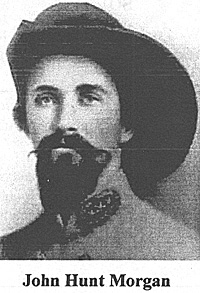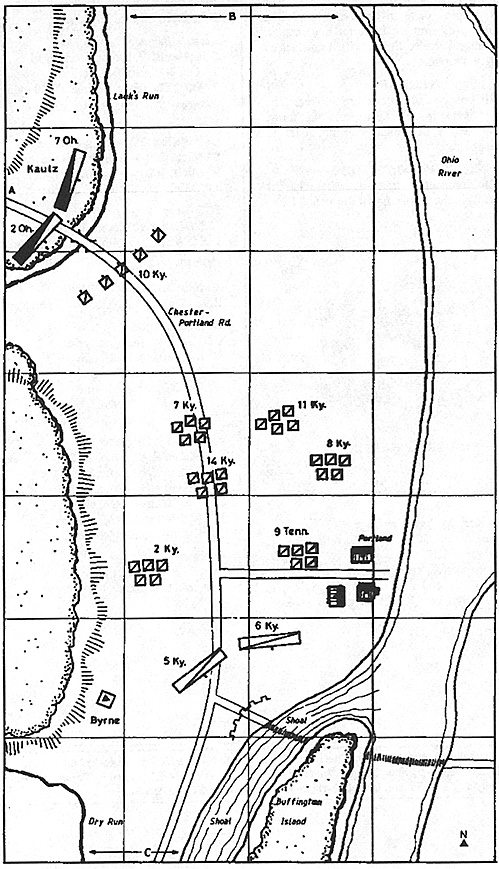
"Our shell and shrapnel created great confusion in the rebel ranks, killing and wounding many. "
- --Lt. Cmdr. LeRoy Fitch, U.S.N.
BACKGROUND
In early July 1863, Brig. Gen. John Hunt Morgan made a daring raid well behind Federal lines. However, he chose to disregard Bragg's orders to remain in Kentucky, and pushed on across the Ohio River. After brushing aside a small force of the Indiana Home Guard at Corydon, the Rebels marauded eastward through southern Indiana and entered Ohio on July 13.
John Hunt Morgan
With all of southern Ohio up in arms against his raiders, Morgan was determined to try to make his escape back to Southern lines via the river crossing at Buffington Island. Accordingly, he marched into the town of Chester on the afternoon of July 18th and, after some delay in locating a guide, set out for the small river hamlet of Portland. Arriving as darkness was rapidly approaching, Morgan decided to wait until the next morning before advancing to the ford at nearby Buffington Island. He made this decision because he could see Union units of unknown strength behind some small entrenchments on the road leading to the river crossing.
During the night, the Ohio militia occupying these works abandoned their position, but the delay in Morgan's advance allowed the pursuing Union cavalry to steal a march on the Southerners. Although they were poorly coordinated, the commands of Henry Judah and Edward Hobson force-marched into positions where they threatened to surround Morgan's raiders. At first light, both Union commands groped forward through a heavy fog toward the Confederate lines. Judah and his men were the first to make contact, running headlong into the Confederate force detailed to capture the approaches to the Buffington Island crossing.
Morgan's time was rapidly running out, and most of his raiders were captured.
Federal casualties numbered approximately 55. The Confederates suffered 57 killed, 150-200 wounded, with 750 captured, with 105 escaping across the river. Six miles upriver, Col. Johnson and 330 more Rebels managed to escape over the Ohio River before the arrival of additiosnal Federal gunboats. The remaining Confederates evaded capture until Morgan finally surrendered on July 26, 1863.
THE WARGAME
The scenario begins at 5 a.m. and ends when the Confederates have either all exited from the north edge of the table at B, or have been surrounded and forced to surrender. They are considered to be surrounded and will surrender when the Union player(s) is able, for three consecutive turns, to block any Confederate line of retreat through clear terrain to the north edge of the table. To block the escape route, there must be a line of non-routed Federal regiments stretching from the river to the tree line. The first three turns are foggy, with visibility being limited to two inches.
The USS Imperial is towing the Federal gunboat USS Moose. Neither is armor-plated, and each can be eliminated in the same manner as an ordinary artillery unit. Neither needs to check morale- Movement is 18 inches per turn downstream (south) and 12 inches upstream (north). The vessels are not allowed to move in shoal water. Only two of the gunboat's Dahlgrens can fire at any one time.
DEPLOYMENT
The Confederate cavalry are all dismounted and mostly disordered at the start of the scenario. The exceptions to the latter are the 10th Kentucky, deployed in skirmish order across the Chester-Portland Road, and the 5th and 6th Kentucky, accompanied by Colonel Duke and Byrne's Battery. Kautz's men begin dismounted. Judah's Brigade enters at C at 5 a.m. Hobson and Sanders arrive at A at 5:45. The U.S.S. Imperial and Moose enter from the south at 5:30. They may not separate.
Ryan Toews and George Anderson. This scenario was updated with additional historical details and a slightly more accurate order of battle by Scott Mingus. Adapted from "A Clash of Sabers," printed by Potomac Publishing and distributed by The Last Square. Used by written permission of George Anderson.
Nearly all the CSA cavalrymen also carried a pair of pistols, helping them in short-range fighting. Remember the die roll modifier for any melees. Most used short-barreled Enfield rifled muskets as their primary weapon.
TERRAIN
All creeks and woods are broken. The Ohio River is impassable apart from the fords, which are treated as rough, causing units to become disordered.
VICTORY CONDITIONS
The Confederates must exit as least half of their troops from the north edge of the map at B.
ORDER OF BATTLE
UNION
Cavalry Brigade, Third Division, Twenty-Third Corps Brig. Gen. Henr' M. Judah, average, +1
- O'Neil's Btn., 5 Ind. 50 men, BLC, average
11th Ky. 600 men, BLC, average
14th Ill. 500 men, BLC, average
Local home guards, 200 men, mixed guns, militia
Henshaw's Ill. Bty. 2x3" R, 4x12lb MH, average
Provincial Cavalry Division Brig. Gen. Edward H. Hobson, average, +1
- Kautz's Brigade Col. August V. Kautz, average, +1
- 2nd Oh. 100 men, BLC, elite
7th Oh. `The River Regiment" 100 men, RM, average
Sanders' Brigade Col. William P. Sanders, average, +1
- 8th Mich. 260 men, Spencer repeaters, average
9th Mich. 300 men, Spencer repeaters, average
11th Mich. Bty. 2x10lb P, green
U.S. Navy
- U.S.S..Imperial, unarmed steamer
U.S.S. Moose, 6x24lb Dahlgren SB, green
CONFEDERATE
Morgan's Cavalry Division Brig. Gen. John H. Morgan, superior, +2
- Duke's Brigade Col. Basil W. Duke, superior, +2
- 2nd Ky. :380 men, RM, elite
5th Ky. 200 men, RM, elite
6th Ky. 280 men, RM, elite
Co. A, 9th Ky., 90 men, RM, elite
9th Tenn. 140 men, RM, average
Johnson's Brigade Col. Adam R. "Stovepipe" Johnson, average, +1
- 7th Ky. 240 men, RM, elite
8th Ky. 340 men, RM, average
10th Ky 200 men, RM, elite
11th Ky. 240 men, RM, average
14th Ky- 140 men, RM, green
Artillery
- Byrne's Bty. Ky. Artillery 2x10lb P, 2xl2lb mountain howitzers, elite

Scott Mingus, Sr. 2004. Inspired by a scenario ŠAdventure Games, Inc 1983 that was first printed in the Johnny Reb scenario booklet. Used by permission of the author, John Hill. Heavily modified by Scott Mingus, Sr. (updated order of battle, map, and historical notes).
Back to Table of Contents -- Charge! # 4
Back to Charge! List of Issues
Back to MagWeb Master Magazine List
© Copyright 2004 by Scott Mingus.
This article appears in MagWeb.com (Magazine Web) on the Internet World Wide Web.
Other articles from military history and related magazines are available at http://www.magweb.com